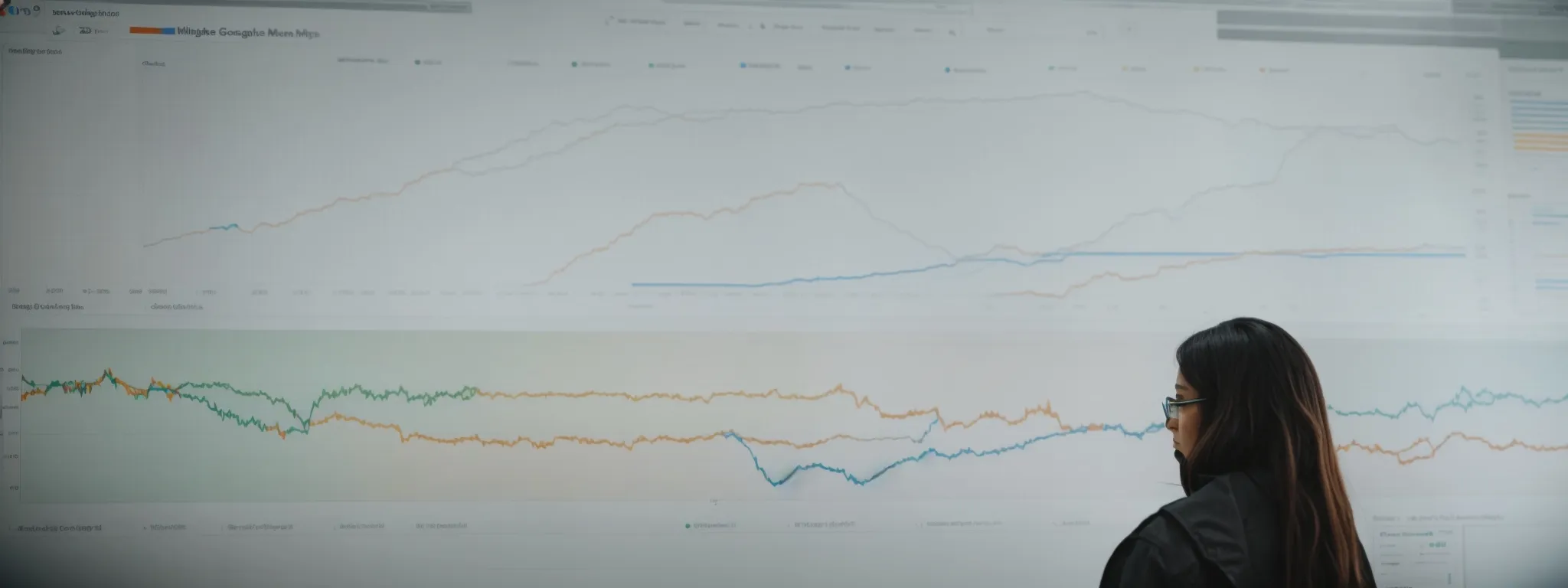Writing Google Core Algorithm User Intent SEO
Mastering User Intent in SEO With Google’s Core Algorithm Navigating the labyrinthine complexities of Google’s core algorithm necessitates a deep understanding of user intent, the cornerstone of […]
Mastering User Intent in SEO With Google’s Core Algorithm
Navigating the labyrinthine complexities of Google’s core algorithm necessitates a deep understanding of user intent, the cornerstone of contemporary SEO.
As search engines evolve, so too must the strategies employed by businesses to capture the nuanced aspirations of their target audience.
It means delving beyond mere keywords to discern the threads of thought that lead a user to initiate a search query.
With LinkGraph’s SEO services, grasping the subtle shifts within Google’s algorithmic patterns becomes achievable, aligning content more precisely with searcher expectations.
Keep reading to unlock the full potential of user intent in your SEO planning.
Key Takeaways
- Proper Understanding and Alignment With User Search Intent Is Essential for Effective SEO Strategies
- LinkGraph Leverages Advanced Tools Like SearchAtlas SEO Software for Granular Analysis of Search Terms and User Behavior
- Crafting Content That Is Engaging and Meets Google’s E-a-T Criteria Ensures Compliance With Algorithm Updates and User Satisfaction
- Continuous Monitoring and Adaptation to Algorithm Changes Are Critical for Maintaining Search Engine Rankings
- Employing Intent Metrics Is Key to Refining SEO Efforts and Improving Content Engagement and Conversion Rates
Understanding Google’s Core Algorithm for User Intent

Mastering Search Engine Optimization (SEO) demands a deep understanding of Google’s evolving core algorithms, especially regarding user intent.
Google’s sophisticated algorithms are constantly refined to interpret the nuances of user queries, with the search engine tirelessly working to match results to the searcher’s purpose, whether informational, transactional, or navigational.
As experts in the SEO field, like those at LinkGraph, scrutinize Google’s continual updates — including the seminal Helpful Content Update and RankBrain — they adapt their strategies to align with how the search engine discerns and prioritizes the underlying intent behind every search term.
This section will delve into the critical role these algorithms play in SEO, reveal insights into how Google ascertains user intent, and explore the implications of recent algorithmic shifts for SEO professionals and content creators alike.
The Role of Google’s Core Algorithm in SEO
The intricacies of Google’s core algorithm shape the bedrock of effective search engine optimization, making an SEO Expert’s Ability to Interpret and Leverage it vital for achieving success. Firms like LinkGraph, equipped with a grasp of algorithm intricacies, tailor their SEO services to ensure that web pages resonate with Google’s understanding of searcher intent, thus improving the likelihood of achieving prominent rankings on the search engine results page.
By staying attuned to the latest algorithm updates, SEO services provided by LinkGraph Navigate the Complexities of search queries with precision. Their approach not only considers the search term itself but also the subtleties of keyword intent, ensuring content aligns with the expectations of both the search engine and the user, an essential practice for businesses aiming to optimise their digital presence effectively.
How Google Determines User Intent
At its core, Google utilizes Natural Language Processing (NLP) and machine learning algorithms like Hummingbird and BERT to dissect and understand the intent of user searches. This technological prowess allows the search engine to discern the subtleties between a visitor looking for knowledge and another seeking to purchase a product.
- Algorithms analyze the semantics of a search query.
- Machine learning assists in recognizing patterns in user behavior.
- NLP interprets the searcher’s language to determine the content type required.
The assessment of user intent extends to the evaluation of on-page factors. This includes scrutinizing the comprehensiveness of content, the relevance of link profiles, and the user experience offered by webpages. LinkGraph’s SEO services capitalize on these aspects by providing a thorough SEO content strategy that anticipates Google’s interpretation of intent.
Recent Updates Affecting User Intent Recognition
Google’s algorithms continue to evolve with the introduction of initiatives like the Helpful Content Update, which places heightened importance on the creation of content that primarily serves the user’s interests. This shift demands that professionals from SEO agencies like LinkGraph meticulously craft content that not only ranks but also provides genuine value to the reader.
In response to these developments, LinkGraph’s SEO services have fine-tuned their tactics to prioritize user-centric content. This involves a commitment to crafting web pages that are both informative and engaging, thus ensuring content meets the new standards set forth for search engine visibility:
- Content must demonstrate E-A-T (Expertise, Authoritativeness, Trustworthiness).
- Writers are encouraged to focus on satisfying searcher intent over simply including keywords.
- SEO strategies must adapt to promote organic traffic growth in light of these algorithmic shifts.
Analyzing User Intent: An SEO Perspective

Professionals engaged in the realm of search engine optimization must navigate the complex terrain of user queries, where the recognition and interpretation of user intent are paramount.
LinkGraph’s SEO services excel in delineating the various kinds of search intents, utilizing cutting-edge tools to identify and analyze the explicit and implicit signals users provide.
This unparalleled insight equips content creators with the means to tailor their approach, ensuring every piece of content not only addresses the user’s immediate needs but also elevates the overall user experience on the web.
These proficient methodologies serve as the cornerstone for devising content strategies that align with the diverse spectrum of user queries encountered in today’s digital landscape.
Breaking Down the Types of User Queries
At the heart of SEO lies the pivotal task of deciphering user queries—a multifaceted challenge that extends well beyond mere keyword insertion. The proliferation of search terms each carries an inherent intent, ranging from seeking knowledge to executing a purchase, all of which are dissected meticulously by the SEO services offered by LinkGraph.
Recognizing the different shades of intent encapsulated within a search query is a nuanced art form, one that SEO experts at LinkGraph have refined. LinkGraph’s SEO services adeptly segment these intents into clearly defined categories:
- Informational intent, where users are questing for knowledge.
- Transactional intent, revealing a readiness to execute a purchase.
- Navigational intent, focused on locating a specific website or page.
These categorizations enable SEO strategies to be more targeted and impactful, aligning content with the user’s exact needs and thereby enhancing the likelihood of a favorable outcome on search engine result pages.
Tools to Identify and Analyze User Intent
Equipping SEO practitioners with robust tools is essential for discerning the myriad nuances in search intent, thus LinkGraph leverages the acumen of their SearchAtlas SEO software to pierce through the veil of ambiguity in user queries. This advanced software suite employs a spectrum of algorithms and intelligence, enabling a granular analysis that cements the relevance of site content to target audience questions and needs.
In their pursuit of precision, LinkGraph’s SEO services incorporate free SEO audits and free backlink analysis into their arsenal, providing a comprehensive view of how search engines may interpret the intent behind a keyword phrase. These audits illuminate opportunities for optimization and ensure that the SEO content strategy not only adheres to algorithmic mandates but also mirrors the seeker’s quest, bolstering the effectiveness of tailored digital marketing efforts.
Interpreting User Intent Signals for Content Creation
Interpreting user intent for content creation is a sophisticated task that involves reading the subtle clues left by web users. LinkGraph’s SEO services use these insights to forge a content marketing plan that not only addresses the stated needs of the searcher but predicts their unstated desires, crafting a narrative that resonates beyond the immediate search query.
Advancements in the tools and analytics provided by SearchAtlas SEO software empower LinkGraph’s content creators to construct narratives that truly engage the target audience. By analyzing patterns in search behavior, LinkGraph is able to discern between user intent signals, enabling the creation of content that doesn’t just inform but captivates, thereby improving both relevance and retention:
| User Intent Category | Content Creation Focus | LinkGraph’s Tailored Strategy |
|---|---|---|
| Informational | Educational and informative content | Answering user queries with depth and authority |
| Transactional | Product details and purchase information | Optimizing product pages to encourage conversions |
| Navigational | Easy access to specific company pages or information | Streamlining site structure for enhanced user experience |
Crafting Content Aligned With User Intent

Addressing the myriad dimensions of user intent, proficient content strategists at LinkGraph craft content to align strategically with the searcher’s specific needs.
Structuring content to meet informational needs, addressing commercial intent with targeted pages, and creating transactional content poised for conversions are cornerstones of their sophisticated SEO content strategy.
This blend of expertise and precision forms a trifecta of content creation that deftly meets the user halfway, facilitating a seamless transition from search query to satisfied visitor.
Structuring Content to Meet Informational Needs
LinkGraph’s approach to constructing content tailored for informational needs hinges on a deep comprehension of the user’s search for knowledge. The firm ensures each blog post, guide, or explainer piece is crafted expertly, featuring well-researched information that establishes domain authority and fulfills the user’s educational quest.
The precision of LinkGraph’s SEO services extends to the application of SEO AI writers that enhance the readability and relevance of informational content. By doing so, LinkGraph ensures that users consistently encounter materials that not only satisfy their search intent but also foster increased engagement and trust.
Addressing Commercial Intent With Targeted Pages
Zeroing in on commercial intent, LinkGraph’s SEO services astutely discern that when visitors are poised to make a purchase, the company’s product pages must shine with persuasive clarity. Each product page is optimized to act as a landing destination, marrying compelling product benefits with Strategic Placement of Target Keywords to drive transactions.
- Optimization strategies transform product pages into conversion engines.
- Seamless integration of relevant keywords bolsters visibility and relevance.
- LinkGraph ensures persuasive content aligns with user’s transactional search intent.
With white label link building at the helm, LinkGraph crafts each product page to convey unmistakable value propositions, guiding the buyer’s journey towards a decisive action. The culmination of a meticulously designed SEO strategy, these pages reflect the intent of users at the crucial moment of decision-making, underpinning successful conversions.
Creating Transactional Content for Conversions
LinkGraph Elevates the Dialogue between a brand and its prospective customers through transactional content that not only captures but converts. The focal point is to present a clear path to purchase, with calls to action that resonate with the buyer’s sense of immediacy and desire for the product.
Eloquent transactional content crafted by LinkGraph’s seasoned team ensures that each product page suffused with commercial intent is an anchor, compellingly steering the buyer towards completion of the purchase funnel. This strategic approach to crafting transactional content is a cornerstone in flipping the visitor’s search term into a business success story.
Optimizing for Google’s Core Algorithm Updates

To truly excel in the realm of SEO, one must not only understand but anticipate the implications of updates to Google’s core algorithm.
The journey of a digital marketing consultant or an SEO expert is one of constant vigilance—their gaze fixed on the horizon where Google’s AI advancements mold the search landscape.
In this crucible of change, SEO professionals from esteemed agencies like LinkGraph are perpetually refining their tactics to remain synchronously aligned with the emerging best practices that safeguard sustained SEO rankings.
This section embarks on an exploration of these guiding practices, shedding light on how businesses can stay ahead with evolving user intent algorithms, adapt to cutting-edge AI developments, and bolster their SEO efficacy in the wake of core algorithm updates.
Staying Ahead With Evolving User Intent Algorithms
Navigating the dynamics of evolving user intent algorithms is a field where LinkGraph’s SEO services excel by providing strategies that recognize and adapt to these shifts. Through the strategic application of their SearchAtlas SEO software, they analyze and predict the course of Google’s algorithmic wind, ensuring content is consistently refreshed and aligned with the latest SEO paradigms.
LinkGraph rigorously trains its squadron of consultants to decipher the signals of changing algorithms, enabling clients to harness this fluidity for competitive advantage. Their proactive stance, combined with a commitment to SEO best practices, positions businesses to thrive amidst the relentless tide of algorithmic refinement.
Adapting to Google’s AI Advancements in Search
In the era where artificial intelligence shapes digital landscapes, adapting to Google’s AI advancements is a strategic necessity for SEO. LinkGraph’s SEO services navigate this terrain with unparalleled finesse: reconciling the sophistication of AI algorithms like BERT with the practical needs of businesses aiming for search engine supremacy.
- Gleaning actionable insights from AI’s interpretation of complex user queries.
- Implementing data-driven SEO strategies that accommodate semantic search trends.
- Adjusting SEO content strategies to reflect the AI’s evolving understanding of user intent.
By leveraging SearchAtlas SEO software, LinkGraph ensures that their clients’ SEO tactics evolve in tandem with AI developments, thus preserving and enhancing online visibility amidst the continuous evolution of search algorithms. It is this agile and informed approach that distinguishes their SEO offerings, positioning clients at the forefront of organic search results.
Best Practices for Sustaining SEO Rankings Post-Algorithm Update
In the wake of pivotal algorithm updates, LinkGraph champions a strategic orientation that prioritizes sustainable SEO practices. These practices maintain a firm focus on quality content, ensuring it adheres to the principles set forth by Google’s Quality Rater Guidelines and incorporates both on-page and off-page optimizations that retain their significance over time.
The longevity of a website’s ranking post-update hinges on Continuous Vigilance and the Aptitude to Align Swiftly with Google’s modifications:
- Regularly conducting comprehensive site and backlink audits to detect and rectify issues before they impact rankings
- Engaging in white label link building to enhance link profiles with high-quality, relevant backlinks
- Updating content to resonate with the latest user intent signals and search term trends
Firms like LinkGraph recognize that SEO is not a one-time endeavor but an ongoing campaign that must adapt with each search engine refinement and core update. By maintaining these proactive measures, organizations ensure they stay at the competitive edge of search engine visibility and user satisfaction.
Incorporating Search Intent Into Your SEO Strategy

Aligning SEO Strategy With User Intent is the linchpin for not only climbing the SERP ladder but also for connecting authentically with one’s audience.
In the grand chessboard of digital marketing, understanding the search intent behind keywords is akin to predicting your opponent’s next move, granting the strategist an upper hand.
With user intent as a guidepost, LinkGraph fashions its keyword research, evolves its SEO methodologies, and polishes content to ensure it resonates profoundly with user needs and the algorithms that interpret them.
This paves the path for enhanced content relevance, boosting user engagement and satisfaction—the ultimate rewards in the relentlessly competitive arena of SEO.
Integrating User Intent With Keyword Research
LinkGraph’s SEO services unite keyword research with user intent to uncover the search terms that matter most to their clients’ target audience. Their methodology cuts through the noise, focusing on the strategic intersection where user needs and search queries converge, ensuring that the keywords chosen drive relevant traffic that aligns with business goals.
Employing SearchAtlas SEO software, LinkGraph’s team conducts an in-depth analysis to map out the target audience’s online journey, correlating keywords with intent to optimize content for the search engine result pages. They prioritize keywords that not only have high search volume but also exhibit clear intent, tailoring content that speaks directly to the needs and desires of the searcher.
Developing a Holistic SEO Approach With User Intent
Developing a holistic SEO approach that marries content with search intent is critical in today’s digital landscape. LinkGraph takes a comprehensive view, ensuring every element of a client’s online presence is attuned to the subtle shifts in user query behavior.
By integrating user intent into the fabric of their SEO strategy, LinkGraph’s team consistently delivers content that meets the evolving demands of search engines and users alike:
- Analyzing the intent behind search terms to guide content development
- Creating personas to enliven SEO strategies with human-centered design elements
- Revising and optimizing content to ensure alignment with ongoing algorithm updates
Enhancing Content Relevance and User Satisfaction
LinkGraph’s SEO services meticulously tailor content to the searcher’s journey, creating a seamless user experience that pivots on relevance. By interpreting the subtleties of search queries, these professionals ensure content not only meets the search engine criteria but resonates with the searcher on a fundamental level.
The success of content in fulfilling user intent directly impacts satisfaction, prompting return visits and higher engagement. Professionals at LinkGraph deploy their SEO expertise to refine content strategies that amplify relevance, fostering a trust-based relationship between brands and their digital audience.
Measuring SEO Success With User Intent Analytics

The pivotal task of an SEO strategist is not only to align content with user intent but also to track and measure its performance meticulously.
In an industry governed by the shifting sands of algorithm updates and user behavior, robust analytics play an essential role in evaluating the efficacy of intent-targeted content.
By harnessing the power of data, professionals at LinkGraph are able to finetune their SEO and content strategies with precision, ensuring that every optimization endeavor is steered by concrete performance markers.
As such, leveraging intent metrics becomes a fulcrum for continuous SEO advancement, underpinning the quest for search engine distinction and audience engagement.
This subsection unfolds the significance of analyzing user intent, providing a framework for a data-driven approach conducive to sustained SEO success.
Tracking the Performance of Intent-Targeted Content
LinkGraph’s SEO services place a strong emphasis on Tracking the Performance of Content tailored to specific user intents. By gathering actionable data through advanced analytics, these professionals gain insights into how well their content satisfies searcher requirements and drives desired outcomes.
Assessing how intent-targeted content influences Key Performance Indicators is critical for refining SEO strategies. LinkGraph’s approach relies on metrics that unveil content engagement levels and conversion rates, painting a clear picture of success or indicating areas needing improvement:
- Analysis of time-on-page metrics to gauge content engagement.
- Evaluation of bounce rates for insights into content relevance.
- Tracking of conversion metrics to assess the effectiveness of transactional content.
Diligence in monitoring these metrics ensures that LinkGraph’s SEO services not only craft content with precision but also continuously optimize it for peak performance in the ever-evolving digital marketing landscape.
Using Analytics to Refine SEO and Content Strategies
LinkGraph’s deployment of sophisticated analytics stands at the forefront of their tailored SEO and content strategies. Through the meticulous sifting of user behavior data, they detect patterns and tweak content to capably match the searcher’s evolving needs.
Data-driven refinements ensure that every strategic SEO move is rooted in empirical evidence rather than speculative trends. LinkGraph thus cultivates an adaptive SEO landscape, wherein client content not only meets the current standards but is resilient to the ebb and flow of future search engine behaviors.
Leveraging Intent Metrics for Continuous SEO Improvement
LinkGraph’s commitment to excellence in digital marketing includes a deep focus on leveraging intent metrics for continuous SEO improvement. This practice involves collecting and analyzing data to understand how users engage with content and how their search intentions evolve over time.
Refining the SEO approach with user intent metrics enables LinkGraph to ensure that strategies are nimble and adept at adjusting to user behavior patterns. Optimizations are methodically applied to enhance visibility and user experience, crafting a pathway for sustained online success.
| SEO Metric | Intent Signal Analysis | Strategic Outcome |
|---|---|---|
| Click-Through Rate (CTR) | Assesses relevance of title tags and meta descriptions to intent | Refines SERP snippets for higher user attraction |
| Keyword Rankings | Tracks alignment of content with user intent and search terms | Adapts keyword focus to mirror intent drifts |
| Conversion Rate | Evaluates the effective call-to-action for transactional intent | Enhances content persuasiveness for increased conversions |
Conclusion
Mastering user intent in SEO is critical for aligning content with Google’s core algorithm updates and ensuring a successful digital presence.
By employing advanced tools and analytics, professionals from agencies like LinkGraph can interpret and cater to the nuances of search queries, enhancing content relevance and user satisfaction.
As Google’s algorithms evolve with technologies like NLP and AI, staying attuned to user intent and adapting strategies accordingly is vital for maintaining competitive search rankings.
Leveraging intent metrics for ongoing improvements allows SEO practitioners to optimize their content strategies continuously, leading to sustained success and superior audience engagement in the dynamic digital marketing landscape.















































































